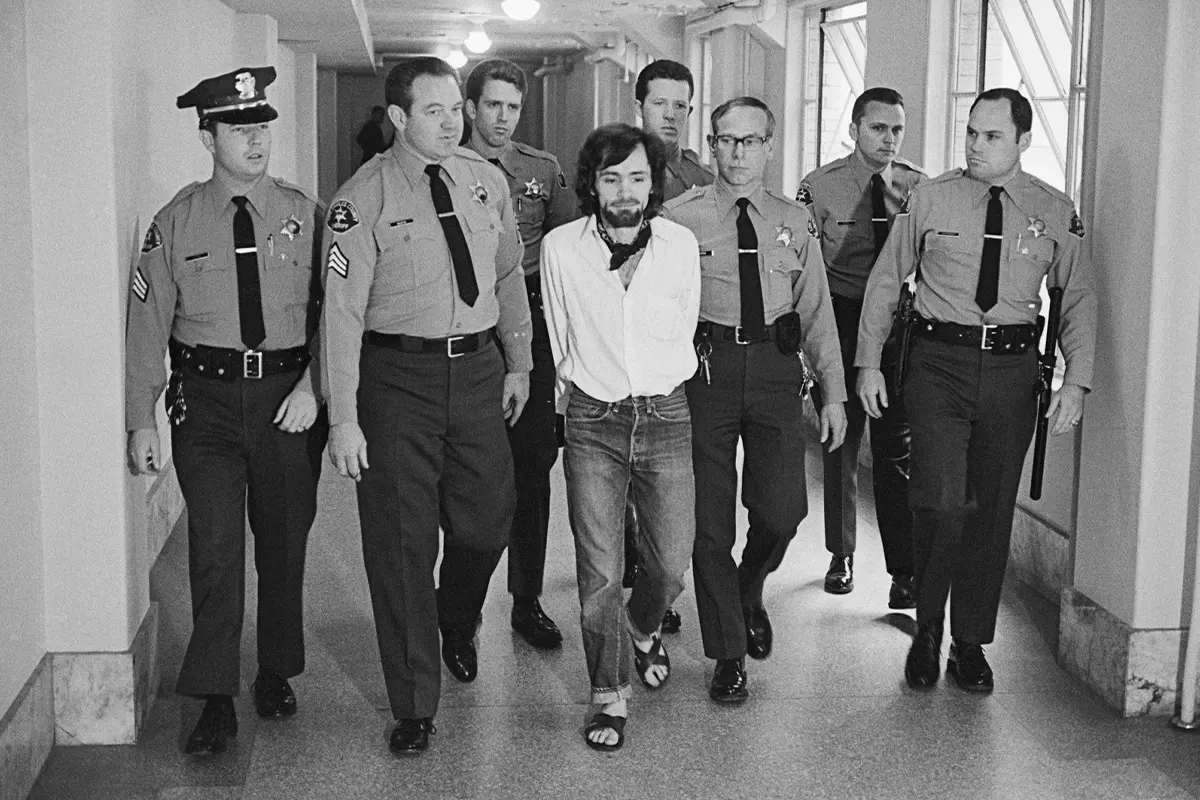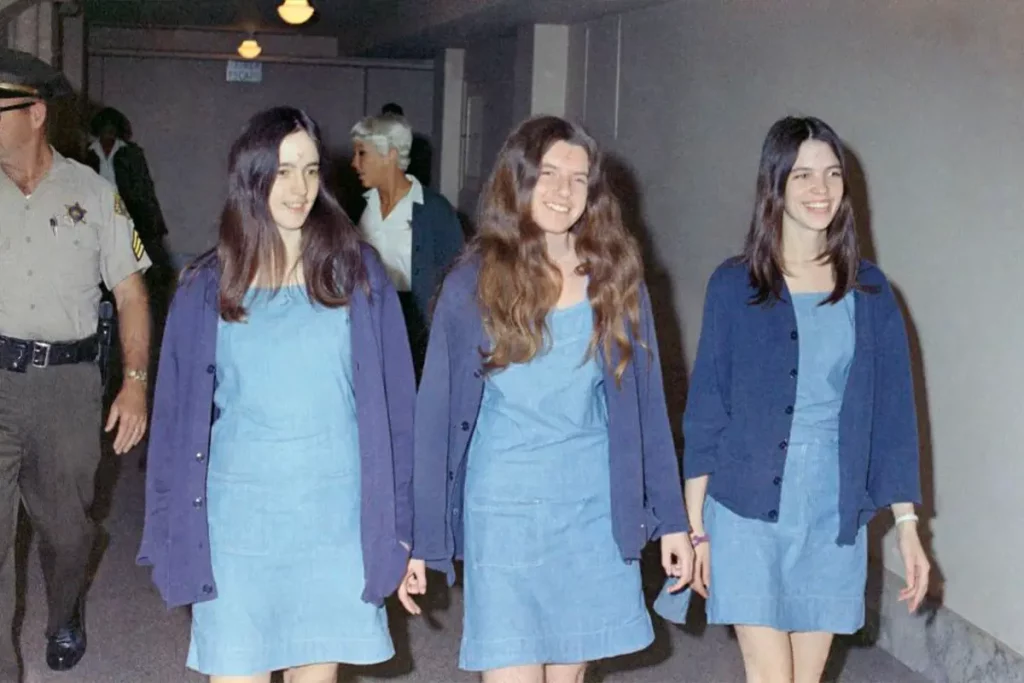«Manson kind of morphs into a nun and the Hills turn into the Alps». How designers have become interested in the macabre representation of the Manson Family in fashion
Leslie Van Houten, an ex-member of the Manson Family
After fifty-three years in jail, ex-Manson follower Leslie Van Houten, has been released. In 1969, nineteen year-old Van Houten was involved in the murder of a Los Angeles grocer and his wife. The Manson Family is widely known for the Tate–LaBianca murders that they carried in LA, California. Like with many gruesome and violent cult members of society, whilst many found it wrong, others found it acceptable to idolize them. Whilst this may be an extreme level of involvement in such cases, Hollywood and the entertainment industry as a whole have played a part in profiting off of and glamorizing the horrors that the Manson Family carried out. The fashion industry is not safe from being scrutinized over this practice.
Cults are notorious for having strong beliefs, mostly radicalized and extreme. As with any other group, branding and symbolism plays a part in their lifestyle, whether directly or indirectly. It is a way for them to create their identity. For the Manson Family, their hippy flair, aux-natural aura and psychedelic folk style was their own; an homage not only to the 60s, but to the horrors they brought.
The more political side of bohemian style – The women of the Manson Family
As a society, we thrive on unconventional muses to inspire our outfits. The more distinctive at the time, the more we appreciate the impact that it has on the industry. In the 1960s, the counterculture movement was in full force, easily identifiable by the bohemian lifestyle. It signified artistic freedom and spiritual awareness over a traditional career path, a conscious choice which many people deemed lazy. To put it simply: this style of dressing went against societal norms, something which is still practiced to this day to represent much more value, more political dilemmas in society. The Manson Family knew this all too well.
The women of the Manson Family, including Van Houten, became unexpected style icons. Flowing maxi dresses, detailed fringe and earthy hues were the norm. In their bid to reject societal norms, the family’s relaxed aesthetic stood in stark contrast to the more structured fashion of the era. With pop culture’s insistent attitude to retelling Manson’s story, the fashion allure has been transformed into an attractive commodity.
Raf Simons inspired by Charles Manson
The juxtaposition between the innocent, bohemian style and the gruesome, devil-may-care attitude which the Manson Family embodied has applied to many fashion brands. Raf Simons, in his Spring 2018 ready-to-wear for Calvin Klein, took inspiration from 60s counterculture. In this, details of retro horror stuck out in the designs. Car crashes, knives and blood stains were all motifs in the designs that walked down the runway.
Boyswear and the Manson Family
In 2015, Boyswear inspired an entire collection on ‘family values’, specifically on the Von Trap and Manson families. The 2016 Spring/Summer collection was named ‘The Manson Family Singers’. Cropped, boxy shapes with patterned shirts and lederhosen-like overalls were a recurring theme throughout the collection.
The designer, Jackson McKeehan, explained that it mostly came about after he read an article about a woman wanting to marry Manson, to then be able to conserve his body once he died. «Manson kind of morphs into a nun and the Hills turn into the Alps», McKeehan said. Of course, the models sported long hair, slick-back bobs and braids, a show and tell of Charles Manson’s style.
Sharon Tate’s influence on the Manson’s fashion legacy
Hollywood actress, Sharon Tate, quickly became the embodiment of the Manson Family’s influence on fashion. The family is infamous for the Tate–LaBianca murders, a series of murders carried out by the members between the 8th and 10th of August, 1969. Van Houten was convicted for the murders of supermarket executive Leno LaBianca and his wife, Rosemary. The night before, other members of the family had killed a pregnant Tate in her Hollywood home, along with friends who were with her at the time.
Her style struck a chord with many designers, now and back then. Whilst the Bohemian style may have a dark angle to it, not everyone sees it that way. For non-extremists, this style was simply a way to escape from everyday societal dilemmas. It is a way to safely and respectfully disagree with political and social radicalism. Tate was known to blend high-fashion with a bohemian twist. Her persona epitomized the 60s flower-child ideal.
Manson Family – Blending a deadly cult into society with fashion: weaponizing style
The allure of counterculture didn’t just stop at classic fringes and bell-bottom pants. Manson embraced it the most, unintentionally becoming a trendsetter for what would become known as outlaw chic. Growing out his hair, going barefoot and sporting denim with leather. People described him as a ‘hippy Christ’. His sense of style matched that of the time: «He looked just like one of us», a Rolling Stones reporter wrote in 1970.
Whilst the fashion represented going against societal norms — something which the cult definitely worked to do — it was a popular choice in that era. Therefore, it masked the violent enterprise perfectly.
Manson figured out that cloaking up to mimic the sense of unrest which the population in LA had at the time was efficient enough to run his cult in the background, undetected. He convinced his female followers, some as young as fourteen, to do the same; dressing them up with a sense of hippy beatitude, similar to Tate’s style.
Manson’s family dogma and beliefs
From the outside, they seemed like every other young girl, careless and free. Yet, after having absorbed Manson’s dogma and beliefs, they quickly turned brainwashed into sexual servitude. This armed Manson with a clear weapon — ideology and fashion branded the cult to flawlessly blend into society.
This realization meant that the family’s legacy on fashion went further than just physical garments. It defied societal norms and commanded attention. Whilst the Manson Family didn’t invent a particular style on their own, they relied heavily on style as a form of cult identity and relatability. At the time especially, rebellion was synonymous with self expression; the epitome of bohemian chic and flower children. In the aftermath, this extreme relationship was perfectly represented by the Manson Family and the impact that they had. It redefined fashion as a medium for political and social statements.
Helter Skelter’s aesthetic – a cultural response to the Manson Family’s legacy
Manson was a lifelong supremacist who had stark idealizations about the Helter Skelter way of doing things. Above and beyond drug-fueled mayhem, his focus was on starting a race war. That was the idea for the Tate–LaBianca murders; kill them and make it look like the Black Panther Party for Self-Defense — an organization with an ideology of Black nationalism and socialism — had carried them out. In Manson’s eyes, this would turn into an excuse to start a full-blown race war.
Just like the ‘deprived-innocent’ style that the Manson Family represented, Helter Skelter style soon became a connection with the times. As a dark and edgy aesthetic, it emerged as a cultural response to the Manson Family’s legacy. This created a subculture, one that was drawn to the macabre side of the era, one which was predominantly occupied by the family and their ideology. As it turned into a fashion statement, it embodied that of the rebellious and chaotic nature of the family.
Helter Skelter subculture and the power of symbolism – the Manson Family
The Helter Skelter aesthetic encapsulates grunge, punk and gothic details. These are all physical attributes which mirror the family’s dark intentions. However, just like with the bohemian chic, it goes much further than the physical garments itself. The family’s sinister narrative is parallel to the macabre and morbid subculture.
Whilst this ideology has been largely kept underground, mainstream fashion — including on fashion runways — have hinted at the subculture. Edgy elements and grunge aesthetics are constantly incorporated with gothic motifs. These may not directly link to the Helter Skelter subculture, yet the power of symbolism and the Manson Family’s legacy towards it is enough to connect certain dots, especially in the fashion industry.
The Manson Family
The Manson Family was a cult led by Charles Manson in the 1960s. They are most famous for the Tate–LaBianca, carried out between August 8th and 10th, 1969. One of their victims was Shanon Tate, a pregnant actress who was a major figure in the Hollywood scene at the time. Just like with many macabre tragedies, the entertainment industry has found ways to profit off of them. The fashion industry is no exception, where trend, high-end designers and unconscious style have all been influenced by the Manson Family and their ideology.




















